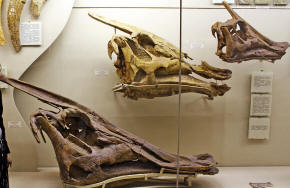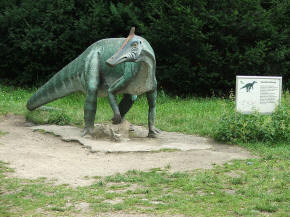|
Description
Saurolophus
is known from material including nearly complete skeletons, giving
researchers a clear picture of its bony anatomy.
S. osborni, the rarer
Albertan species, was
around 9.8 meters long (32 feet), with its skull a meter long (3.3 feet). It
weight is estimated at 1.9 tonnes (2.1 tons).
S. angustirostris,
the
Mongolian species, was
larger; the type skeleton is
roughly 12 meters long (39.4 ft), and larger remains are reported. Aside
from size, the two species are virtually identical, with differentiation
hindered by lack of study.
The most distinctive feature of
Saurolophus is its
cranial crest, which is present in young individuals but is smaller. It is
long and spike-like and projects upward and backward at about a 45 degree
angle, starting from over the eyes. This crest is often described as solid,
but appears to be solid only at the point, with internal chambers that may
have had a
respiratory and/or
heat-regulation function.
Discovery
and history
Barnum Brown recovered the first
described remains of Saurolophus
in 1911, including a nearly complete skeleton (AMNH
5220). Now on display in the American Museum
of Natural History, this skeleton was the first nearly complete dinosaur
skeleton from Canada. It was found in rocks of early Maastrichtian
age, in the Upper Cretaceous
Horseshoe Canyon Formation
(then known as the Edmonton Formation) near Tolman Ferry on the Red Deer River in
Alberta. Brown wasted little time in describing his material, giving it its
own subfamily.
Saurolophus
was an important early reference for other hadrosaurs, as seen in the names
of Prosaurolophus
("before Saurolophus")
and
Parasaurolophus ("near
Saurolophus").
However, little additional material has been recovered and described.
Instead, more abundant remains from
Asia have provided more
data. Initial remains were not promising: a partial fragmentary
ischium from Heilongjiang, China that Riabinin
named
S. kryschtofovici.
Much better remains were soon recovered, though, but from Mongolia's early
Maastrichtian-age
Nemegt Formation. The
1947-49 Polish-Mongolian
Paleontological Expedition recovered the large skeleton that became
S. angustirostris as
described by
Anatoly Rozhdestvensky.
Other skeletons from a variety of growth stages have also been discovered,
and S. angustirostris
is now the most abundant Asian hadrosaurid.
Species
Two species are regarded as valid
today: the
type species S.
osborni, and S.
angustirostris. S.
osborni (Brown, 1912) is known from a skull and
skeleton, two other complete skulls, and skull fragments.
S. angustirostris
(Rozhdestvensky, 1952) is known from at least fifteen specimens.
S, kryschtofovici
(Riabinin, 1930) is not considered valid; either it is regarded as a
dubious name, or as a
synonym of S. angustirostris
(although it predates S. angustirostris).
Paleoecology
S. osborni
shared the Horseshoe Canyon Formation with fellow hadrosaurids Edmontosaurus and
hollow-crested Hypacrosaurus,
and many other dinosaurs including horned
dinosaurs, raptors, pachycephalosaurs, and the
tyrannosaurs
Albertosaurus and
Daspletosaurus. The
dinosaurs from this formation are sometimes known as Edmontonian, after a
land mammal age, and
are distinct from those in the formations above and below. The Horseshoe
Canyon Formation is interpreted as having a significant marine influence, due
to an encroaching
Western Interior Seaway,
the shallow sea that
covered the midsection of North America through much of the Cretaceous.
S. osborni may have
preferred to stay more landward.
S. angustirostris
was one of the largest herbivores of the Nemegt Formation, which lacked
large horned dinosaurs but had sauropods and a more
diverse theropod fauna. It coexisted with the rare crested hadrosaurid
Barsboldia,
raptors, several
oviraptorosaurians, the
ostrich-mimics
Gallimimus and
Deinocheirus,
Therizinosaurus,
and the
tyrannosaurid
Tarbosaurus. Unlike
other Mongolian formations like the well-known
Djadochta Formation
that includes
Velociraptor and
Protoceratops, the
Nemegt is interpreted as being well-watered, like the
Dinosaur Park Formation
in Alberta.
Paleobiology
As a hadrosaurid,
Saurolophus would have
been a bipedal/quadrupedal
herbivore, eating a
variety of plants. Its skull
permitted a grinding motion analogous to chewing, and its teeth were continually
replacing and packed into dental batteries that contained hundreds of teeth,
only a relative handful of which were in use at any time. Plant material
would have been cropped by its broad beak, and held in the jaws by a
cheek-like organ. Its
feeding range would have extended from the ground to ~4 meter (13 ft) above.
Common S. angustirostris
would have been an important large herbivore in the
Nemegt Formation, but
S. osborni was rare
in the
Horseshoe Canyon Formation
and faced competition from other duckbills (Edmontosaurus
and
Hypacrosaurus).
Comparisons between the
scleral rings of
Saurolophus and modern
birds and reptiles suggest that it may have been
cathemeral, active
throughout the day at short intervals.
Crest
The distinctive spike-like crest of
Saurolophus has
been interpreted in multiple ways, and could have had multiple functions.
Brown compared it to the crest of a
chameleon, and
suggested it could provide an area for muscle attachment and a connection
point for a nonbody back frill like that seen in the
basilisk lizard.
Peter Dodson
interpreted similar features in other duckbills as having use in sexual
identification. Maryańska and Osmólska, noting the hollow base, suggested
that the crest increased the surface area of the respiratory cavity, and
helped in thermoregulation.
James Hopson supported
a function as a visual signal, and further mentioned the possibility that
there were inflatable skin flaps over the nostrils that could have acted as
resonators and additional visual signals. This idea has been picked up by
authors of popular dinosaur works, such as
David B. Norman who
discussed hadrosaurid display at length and included a life restoration of
such an adaptation in action.
Return to the
Old Earth Ministries Online Dinosaur
Curriculum homepage.

Shopping
Bay
State Replicas - Skull (Listed as "Duckbill Skull")
Black
Hills Institute -
|
_small.jpg)

